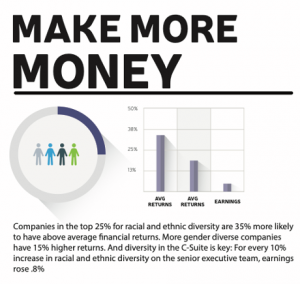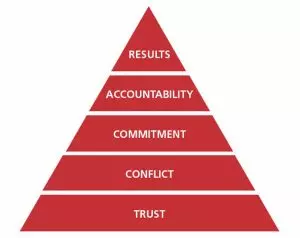By Franck Saragossi
“Not finance. Not Strategy. Not technology. It is teamwork that remains the ultimate competitive advantage, both because it is so powerful and so rare.” — Patrick Lencioni, The Five Dysfunctions of a Team: A Leadership Fable
Companies spend millions of dollars on seminars, motivational speakers, and improving employee skills, and all of these efforts are valuable. Yet building a trusted leadership team can be neglected, despite it being perhaps the most important component of a successful business. As goes the leadership team, so goes the organization.
Recent news highlighted the need to have a diversity-inclusive management team—and for good reason. A diverse group is good for individuals, the community, and companies’ revenue.
According to a 2017 “diversity and innovation survey” conducted by Boston Consulting Group, an above-average company diversity score results in average innovation revenue of 45%, which is nearly double the innovation revenue of less-diverse companies.
Another survey by the Kaleidoscope Group found that companies ranked in the top 25% for racial and ethnic diversity are 35% more likely to have above-average financial returns. It also showed that diversity in the C-Suite is essential: for every 10% increase in racial and ethnic diversity on the executive team, earnings rose 0.8%.
One of the essential parts of building a successful leadership team is amplifying the voices of those whose perspectives differ from yours. If every person in the room agrees with you, then you are not building a strong foundation. Innovation and progress feed off diversity. Leadership groups comprised of different genders, backgrounds, cultures, and countries—and crucially, varying approaches and experiences—contribute to a more creative and open-minded team.
That said, building a diverse team is only the beginning. Ensuring that everyone works together is a more challenging task. Functional teams of all compositions require Trust, healthy Conflict, Commitment, Accountability, and effective Results.
How to a build functional leadership team
Start with your core values
Many companies have a set of 5-10 core values posted in the kitchen area along with the other standard HR posters. At the most basic level, this lets employees know that the company has values and promotes them. But it takes a lot more work to communicate the real importance of core values—how they fundamentally represent the expected behaviors in a company. Core values are the glue that drives and aligns how people act, approach their job, interact with others, and ultimately perform.
Defining them is a discovery process that should be done as a leadership team rather than merely being a few aspirational words created by the founder. Core values are lived every day in the organization. And one of their greatest benefits is that they can attract the right talent and repel those who will never fit the company. Clarifying core values and putting them into action is the first step in establishing Trust.
Encourage diversity through open-mindedness and healthy conflict
We’ve seen research that shows diversity results in innovation. And some of the other practical benefits of different people and points of view are a more complete read on the marketplace and your customer base, as well as a broader range of options when the team makes critical decisions. But true diversity isn’t just about hiring different types of people; companies should actively make sure everyone has a voice and encourage healthy conflict. A word of caution: to accomplish this, leadership must instill a culture of openness, a willingness to be vulnerable, active listening, and respect. These factors are what separates healthy conflict from adverse drama. Any discussion and disagreement must be around the issue—not the people. Never make it personal.
Nevertheless, even companies with the right culture may find that managing discussions is a challenge. The solution is often a facilitator who focuses on identifying the issues, discussing them, and bringing exchanges to a resolution that leads to action points—a concrete to-do list that propels the resolution forward. These components combine to create healthy conflict that flows into leadership’s commitment to a course of action.
Accountability
Execution is the ability to deliver on specific pre-established objectives. And accountability is the Achilles’ heel of execution. Effective and trusted leadership teams establish clear, measurable objectives to be reached within 90 days or a quarter. These tangible goals align both the leadership team and all individuals in delivering an agreed-upon end-state. The 90-day objectives are reviewed weekly by the leadership team, a rhythm that is essential for creating accountability around execution.
Ask yourself again: do you trust your leadership team, and do they trust each other—and you? And is the team achieving the results you want? If you don’t answer those questions with a resounding “yes,” there is good news: you can do something about it.
Prioritizing diversity and building a culture of openness and vulnerability can improve leadership teams. And by establishing Trust, healthy Conflict, Commitment, and Accountability, teams will execute on objectives and reach Results. Management consultant Patrick Lencioni defined these building blocks in his famous “Trust Pyramid” for a reason. Their inverse qualities make up the title of his book: The Five Dysfunctions of a Team.
Invest in your leadership structure as much or more than you do training or technology. The benefits reaped from a high-functioning team that executes well usually make the difference between companies that thrive or fail.
The Profit Recipe helps entrepreneurs run their businesses instead of the businesses running them. We do it by aligning leadership around a unified vision and installing focus, discipline, and accountability to create a cohesive team that delivers exceptional results.
[/et_pb_text][/et_pb_column][/et_pb_row][/et_pb_section]







